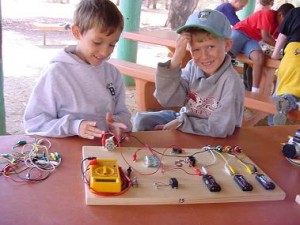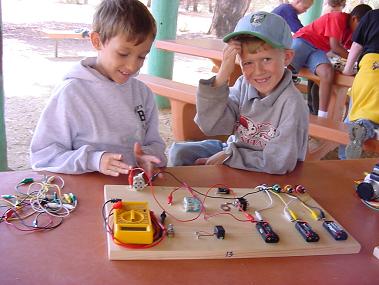Click here for a printable version of this page.
There are 18 scientific principles, most of which kids need to know before they hit college. With the content in this unit, you’ll be able to quickly figure out what they know and where the gaps are, so you can focus on the areas you need to most.
Once kids have wrapped their heads around these ideas, they can pretty much explain the universe around them, including why airplanes fly, how electricity works, and why socks disappear in the dryer.
Don’t worry if these ideas are new to you – it may have been that no one has ever explained them to you or how important they are. The content in this unit is just a quick overview of what we’ll be learning in the main e-Science Online Learning program. The content in this program can be stretched over several years, so don’t try to cover it all in one night.
You’ll be able to tell when your child has mastered these principles in the way they describe how things work when they teach these ideas to others.
One of the most important things you can do as parents is to focus on the long-term outcome (how to think like a scientist), not how quickly you can get your child to memorize these top principles.
Scientists do real science by being patient observers, getting curious about the world around them, and asking questions.
There seems to be a predominant myth about scientists: that real scientists put on a white lab coat, walk into their lab, and have an ah-HA! moment about how to cure the common flu or invent warp drive and then fame and fortune follows (along with a wild hairdo).
That’s not the way real scientists do science. In fact, nothing could be further from reality.
 Real scientists are everyday folks that have a curiosity mindset (How does that work? Why did that happen? What’s really going on here?) and are really good at watching the world around them. They see things in ways most people overlook. Why are things overlooked? Either because they are too busy or just weren’t trained to think like a scientist.
Real scientists are everyday folks that have a curiosity mindset (How does that work? Why did that happen? What’s really going on here?) and are really good at watching the world around them. They see things in ways most people overlook. Why are things overlooked? Either because they are too busy or just weren’t trained to think like a scientist.
Thinking like a scientist is a way you train your mind to focus on how you can make things better for people or the planet. It’s a way of contributing while at the same time challenging yourself to understand something that you didn’t just a moment ago. It’s fun to figure things out if they are not too far out of reach. Just as you wouldn’t teach a toddler to sky-dive, we wouldn’t start you on your science adventure with stuff that too complicated to understand. We’ll make sure to go at your pace and throw enough solid content your way so you grow in order to keep up.
One of the quickest ways to kill your child’s passion for science is to not teach him how to deal with frustration when it pops up. If you’re anxious about doing science because you don’t want him to ever feel frustrated while doing science, let me tell you the good news up front:
SCIENCE CAN BE FRUSTRATING! This is especially true if you’re doing an experiment right in front of other people.
While every scientist gets to feeling frustrated or disappointed at times, they also don’t stay there long. When an experiment goes awry, or something doesn’t work, it’s important to work through these emotions (and events) with your child so they get into the habit of picking themselves up, brushing themselves off, and getting back in the saddle. What this usually means is taking a closer look at your experiment setup, your original ideas and guesses and see what happened.
Everyone gets frustrated. It’s part of life, part of reality. What’s not realistic is letting frustration stop you, or even reliving the same frustration over and over in your mind. That’s not how the real world operates. Everyone experiences setbacks, and the sooner your child figures out how to deal with these, the more resilient they are going to be and the faster they’re going to learn what works and what doesn’t.
In fact, one of the greatest experiments of all time gave a null result, which baffled top scientists for decades until Einstein came to the rescue with his special theory of relativity. It was the 1887 Michelson-Morley experiment that failed to detect the Earth’s motion through the ‘ether’. It’s good thing, too, because now we know the truth Einstein’s relativity principles that tell us the speed of light being constant for all observers (we’ll cover more of that in Unit 7).
We’re going to focus on the top scientific principles that will make you a brainiac extraordinaire. You might be surprised at the materials or experiment setup. But real science doesn’t need to be fancy – you can demonstrate all of these spades of science for dirt cheap. Ready?
Newtonian Physics
Scientists study motion. They study how things move through space and time in order to understand and predict the world.
The Principles of Galilean (Newtonian) Relativity are where Einstein’s original principles of relativity came from. The ideas that “I am at rest” don’t mean anything unless you talk about your motion relative to something else.
There is a natural state of motion to move at constant speed in a straight line. When you toss a ball, it wants to go in a straight line. But air resistance (drag) and gravity are working to bring it to a stop. Launch a Voyager spacecraft into space and it goes in a straight line until it hits something or is gravitationally affected by another object.
Newton’s three laws of motion (which are based on Galileo’s work) make all motion predictable once we know all the forces acting on the object:
Please login or register to read the rest of this content.

